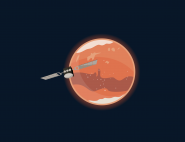Omega Instrument
(Observatoire pour la Minéralogie, l'Eau, les Glaces et l'Activité)
![]()
OMEGA's camera and electronic bay
The OMEGA instrument is an imaging spectrometer operating in the visible and near-infrared domain. It has two spectral channels, respectively working in the ranges of 0.38 to 1.05 µm (VNIR channel–Visible and Near Infrared) and 0.93 to 5.1 µm (SWIR channel–Short Wavelength Infrared).
OMEGA will supply a global cartography of the planet with a two to five kilometre-resolution for observation altitudes ranging from 1500 to 4000 km, and for selected regions, high spectral resolution images (< 350 m), during view taking near the periapsis (altitude < 300 km).
OMEGA provides information on:
- The characterization of surface composition, by identification of the composition and of the spatial and temporal distribution of the different minerals (silicates, hydrated minerals, oxides and carbonates) in the soils, frosts and ices;
- The study of the spatial and temporal distribution of CO2, CO, H2O and aerosols (dust particles) in the atmosphere.
| Images of the south polar ice cap taken by OMEGA (altitude ranging from 1500 to 2000 km). CO2 ice can be seen (left image decreasing concentration from blue to brown) as well as H2O ice (right image decreasing concentration from blue to red). The comparison between the two pictures shows an extension of water ice beyond the zone covered by CO2 ice. Other results are presented in a publication about the first scientific results of OMEGA. | |
Different institutes collaborated to the OMEGA instrument development:
- IAS - Institut d'Astrophysique Spatiale (France): SWIR channel development;
- LESIA - Laboratoire d'Etudes Spatiales et d'Instrumentation en Astrophysique (France): SWIR channel development;
- IFSI - Instituto di Fisica dello Spazio Interplanetario (Italy) VNIR channel development;
- IKI - Russian Institute of space research (Russia): scanner development (subcontracting).
The charts below summarize the main characteristics of the VNIR and SWIR channels:
| Telescope | Double Gauss objective |
| Field of view | 8.8 ° |
| Spectrometer | Concave holographic grating |
| Detector | CCD Thomson TH 7863 (384x288 pixels) |
| Detector size | 8.8 x 6.6 mm² |
| Pixel size | 23 x 23 µm² |
| Spectral range | 0.38 - 1.05 µm |
| Spectral resolution | 7 nm |
| Telescope | Cassegrain |
| Instantaneous field of view | 4.1 arcmin |
| Total sweep angle | ± 4.4 ° (128 x 4.1 arcmin) |
| Spectrometer | Concave holographic grating |
| Detector | InSb photodiode linear array by SAT |
| Detector size | 128 photodiodes with step 120 µm |
| Pixel size | 90 x 120 µm² |
| Range C L | 0.93 - 2.73 µm 2.55 - 5.1 µm |
| Resolution C L | 14 nm 21 nm |
The chart below summarizes the main resources related to OMEGA.
| Mesured on the Flight Model | ||
| Mass | Camera | 23.5 kg |
| Electronic | 4.6 kg | |
| Harness | 0.7 kg | |
| Power | Initialization | 10.6 W |
| Pre Observation | 27.4 W | |
| Observation | 47.6 W | |
| Post Observation | 10.6 W | |
| Telemetry Rate | Minimum | 36 kbits/s |
| Typical | 292 kbit/s | |
| Maximum | 686 kbit/s |


